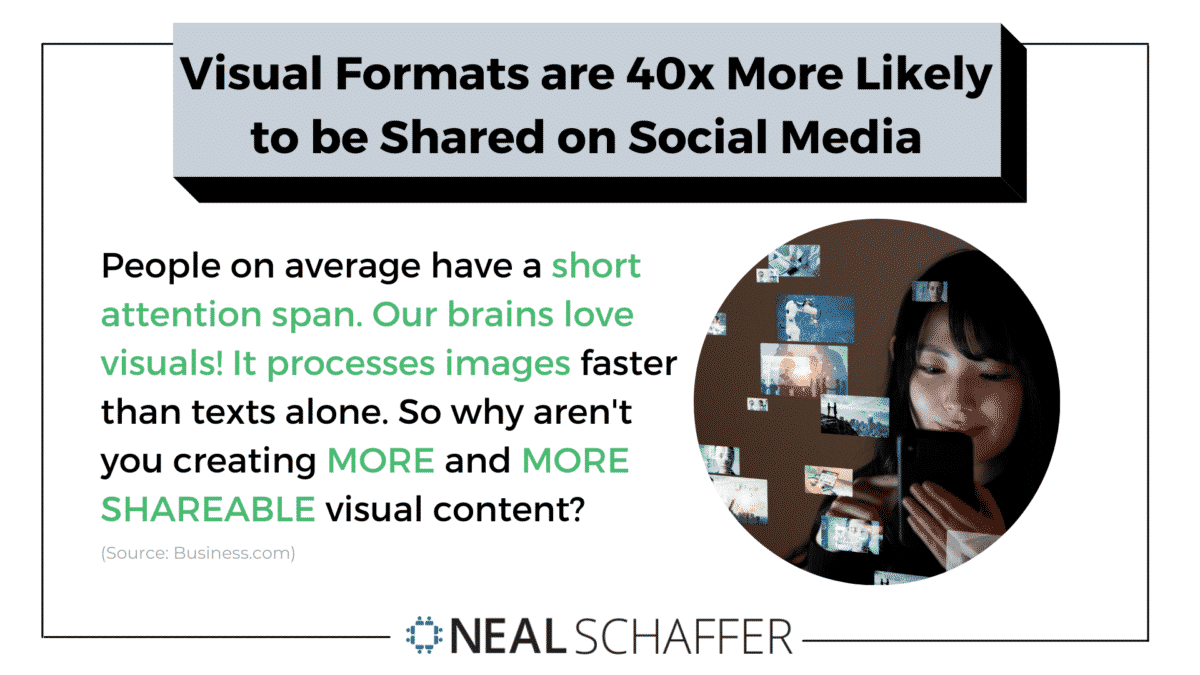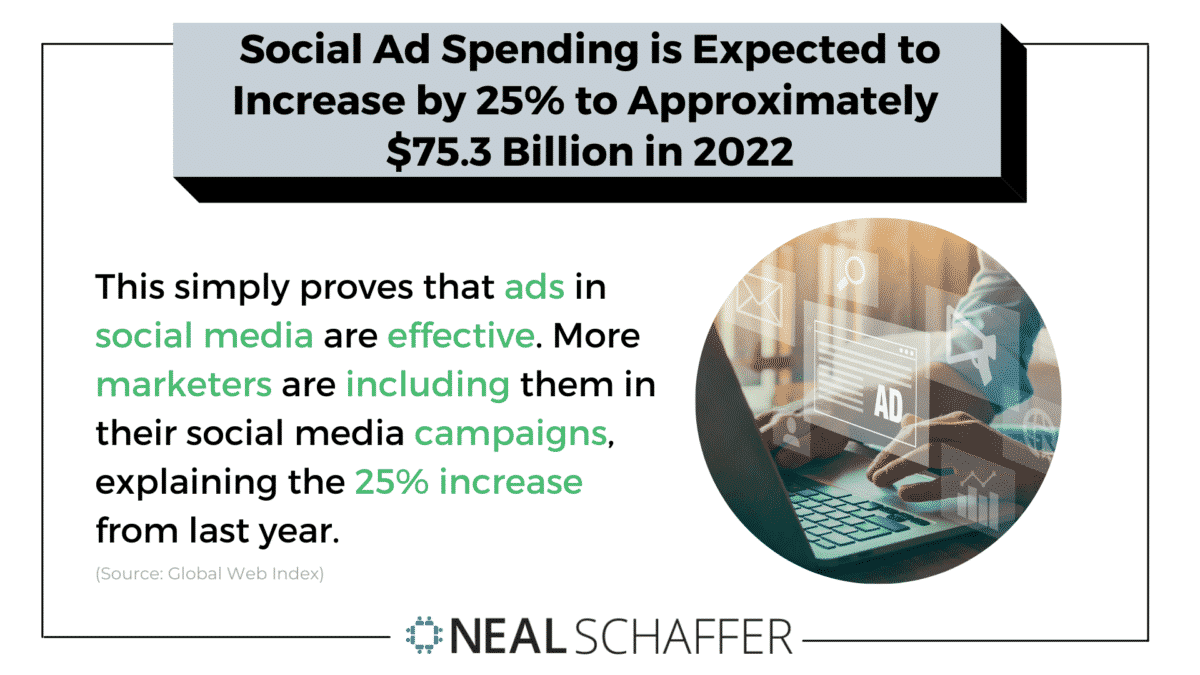Understanding the latest social media marketing statistics and the general social media landscape is critical to your marketing success today.
Why?
As marketers, we know that brand growth is a numbers game.
Even with brand awareness, there’s a number that can describe an increase or decrease in each KPI.
However, the marketing world has changed a lot over the last decade. In particular, social media marketing has become more than just paid advertisements on a single popular platform. Younger generations don’t even remember a time when social media wasn’t an important part of their lives–and, consequently, when their favorite social network was not inundated with digital marketing campaigns!
Now more than ever, if you aren’t marketing on at least one social network, you are missing out on a lot of sales. In fact, you’re probably falling behind in your marketing campaign efforts. Let’s take a look at the social media advertising statistics behind these realities that showcase the impressive social media marketing growth over the years.
Social Media Usage Statistics from Around the World

Social media is widely used by people all over the world, from the Twitter X user base who use it for a source of news to Facebook messenger devotees. While it does require an internet connection, even this requirement is getting easier to meet. Smartphones, for instance, are easier to use than laptop or desktop computers for the average user. Even on slow internet connections, social media is opening up a new world for people in developing countries. For developed countries, social media is almost ubiquitous and designed for daily users–and social media marketers need to take note.
Let’s take a look at some of the most interesting social media marketing facts.
1. There are now 4.9 billion people around the world using social media. (source)

2. This represents about 60% of the global population and 94% of internet connected people. (source)
3. The average social media user spends a whopping 151 minutes, or 2 hours and 31 minutes, on social every day. This provides many opportunities to reach customers. (source)

4. Internet users in Brazil spend the most time on social media daily: 3 hours and 49 minutes! Philippines and Nigeria are not too far behind them. (source)
5. The part of the world with the highest level of social media saturation are in Northern Europe and Western Europe. Saturation rates in these areas stand at 84% and 83% respectively. (source)
6. By contrast, the African continent social media saturation ranges from 7% (Middle Africa) to 41% (Southern Africa).
7. Facebook remains the most widely used social media platform with nearly 3 billion monthly active users. If someone tells you that Facebook is dead, run for the hills! (source)

8. While TikTok has seen rapid growth as the fastest-growing social media platform with the popularity of short-form videos, it has not been as universally accepted by global Internet users as Facebook has. That being said, although relatively new, TikTok already has more than 1 billion monthly users. (source)
9. In comparison, Instagram falls in between Facebook and TikTok with more than 2 billion active monthly users. (source)
10. Furthermore, Instagram Stories alone has more than 500 million daily active users. (source)
11. Finally, video ads posted on Instagram Reels potentially reaching up to 675 million users, giving you a feel for how massive a presence Instagram is. (source)
Further Reading: Social Media as a Catalyst for Social Change
Is Your LinkedIn Working?
Just released: my new book to help professionals, entrepreneurs, and business owners maximize LinkedIn for real growth.
With years of LinkedIn expertise, Maximizing LinkedIn for Business Growth offers actionable steps to build your brand, expand your network, and drive results.
Start leveraging LinkedIn like never before—grab your copy now! Click the cover or button below to buy on Amazon.
Social Media in the United States

Since the United States is both where most popular social networks were created and is home to the world’s largest economy, what goes on here is vital for most brands looking to improve their reach on social media networks.
In addition, the US is home to Silicon Valley, the largest source of technological innovation in the world.
American internet-related statistics are also important because of the huge number of users concentrated in one place. Finally, Americans buy a lot of goods and services relative to their incomes, making entry into their social media channels absolutely vital for digital marketing strategies.
12. In the US, at least 82% of internet users are on social media. The total number of social media users will likely reach 257 million by the end of 2023. (source)
13. Most American adults don’t limit themselves to just one social network. In fact, the average American has 7.1 social media accounts while the global average is 8.4 accounts. (source)

14. Social media has a wide range of saturation based on age. Millennials lead the way with 90.4% being active users. For Gen X, that number is 77.5%, and Baby Boomers still participate at a rate of 48.2%. (source)
15. Studies show that 90% of teenagers have used or are using social channels. (source)
16. Even when the entire adult US population is considered, social media is widely used. In fact, 68% of adults are on social media. There are few places which are so effective at reaching customers. (source)
17. Children are getting social media profiles relatively young. In fact, an astounding 44% of 8-11-year olds are on at least one social media network. This number increases sharply in 12-15-year olds, with usage at 87%. (source)
Social Media Usage by Device

Remember when slow desktops were the only way to access the internet? Well, times have changed, to the relief of social media platforms and active users. For sure, most of us have at least one laptop or desktop, if only for work or school. But for consumers in developing countries, mobile phones (and mobile internet) are the main way to get online. In addition, children may have a greater level of access to smartphones than they do a laptop. These factors and others have led to mobile phones becoming an important way to access social media. These social media marketing statistics will show you that social media marketers must take pains to ensure that their marketing efforts on social media are optimized for mobile platforms.
18. Smartphones and other mobile devices are used by 91% of social media users. These social users often use their mobile phones to access social networks. (source)

19. Social media users spend almost 80% of their social media time using the platform’s mobile versions. (source)
20. About 99% of social media users will use a mobile connection to view these sites at some point. (source)
Further Reading: The Future of B2B Social Media Marketing: Trends and Predictions for 2025 and Beyond
How Social Media Users Engage with Content

Video has been a big thing ever since it came out, and modern technology has made it easier than ever to produce it. The fact that video hasn’t lost its luster is one thing that becomes evident from these statistics. Along with pictures, visual content is an important part of modern life. Another thing we can see from the numbers is that video content doesn’t always stay on social media. Rather, the impact of content creators often spreads far beyond their native medium.
Here are some of the latest social media trends vis a vis content and user-generated content that you should use to inform your content strategy.
21. Sharing and engagement often happen away from where a piece of social media content was posted. In fact, 84% of content sharing happens outside of social media on other platforms, including instant messenger, email, and SMS. (source)
22. Of all content types, visual formats are 40x more likely to be shared on social media. (source)

23. You can get a much higher engagement rate on posts by tagging them with another location (79%) or user (56%). (source)
24. Sharing branded video content is popular, with 74% of customers doing so. (source)
25. Internet users are saying “no” to ads on social media, with more than 40% turning on ad blockers. (source)
26. Video posted on social media has earned new customers for 93% of brands. (source)

Further Reading: Share of Voice vs. Share of Market: What’s the Difference and Why It Matters?
How Social Media Influencers Consumer Purchases

Like the television of the past, social media is becoming a major driver of consumer decisions. In fact, many people turn to social media to decide what to buy, making social marketing efforts an indispensable part of digital marketing. In addition, customer service is sometimes done via social media sites. One of the reasons for this is that people like to work with brands who others say is OK, and which are attentive to consumers.
27. Among people who buy things online, 97% have accessed social media in the previous month. (source)
28. Among American internet users between the ages of 18-34, almost 40% have bought a product from social media. (source)
29. Product research is one reason why 76% of internet users access social media. (source)

30. Customers who have enjoyed positive social media interactions with brands recommend the brand to social contacts at a rate of 71%. (source)
Further Reading: The 6 Different Types of Social Media Marketing: Find the Best Fit for Your Brand
31. Social media-based influencer recommendations help 49% of consumers decide what to buy–and around 80% of consumers have purchased something after seeing it recommended by an influencer. (source and source)

32. For 13% of social media users, having a “buy” button would make them more likely to buy through the platform. (source)
Further Reading: 20 Best Social Media Analytics Tools to Empower Your Marketing in 2025
Social Media User Relationships with Brands

Social media is all about relationships and human connections. Far from being relegated to personal connection, this connectedness also extends to brands and their digital marketing strategies.
For many internet users, social media is a major gateway to the world, and where people compare notes about products and services. Furthermore, word about events or experiences, good and bad, travels fast on social media apps .
For those reasons and many more, social media marketing tactics are among the best tools for reaching out to customers.
33. Among internet users ages 18-34, 95% will follow at least one brand on social media. (source)
34. Brand discovery from online sources comes through social media 52% of the time. (source)

35. For 43% of all internet users, social media is a major source of information on what to buy. It is also a great way to stumble upon new products, no matter the precise type of content being used in social media marketing efforts. (source)
36. Brand familiarity–or the ability to see and become familiar with brands–influences 80% of customers to purchase something. (source)
37. Social media has been a method of communicating with brands and businesses for 90% of those with an account. (source)
38. Companies are expected to use social media to provide customer service by 70% of customers. (source)
39. Interacting with customers on social media leads them to spend 20-40% more money on products and services. (source)
40. Among consumers between 18 and 29, 49% admit to buying something in response to a social media ad. (source)
Further Reading: How to Conduct a Social Media Audit the Easy Way
What Social Media Users Expect from Brands

Now more than ever, speaking out about issues on social media is crucial for brands. In addition, users like to know about any service or product changes that are taking place. Social responsibility among companies and taking a stand on current issues are increasingly being demanded of corporations. Finally, companies should be careful about which side they are on, because some customers make buying decisions on that basis. If digital marketers include stances on social channels, they may see a decline in some of their audience members (but may make up that decline with similarly-minded internet users).
41. For 86% of Americans, transparency on social media is so important that they will take their business elsewhere if a brand refuses to show transparency. This is an all-time high and should factor into your next marketing campaign. (source)

42. Over half, or 53%, of social media users say that transparency regarding changes to products and services is critical. They also expect companies to express values on social media. (source)
43. Of all social media content types, video is considered the most transparent content type by 67% of consumers. Taking that one step further, 43% of consumers believe that live video is the most transparent form of content creation. (source and source)
44. Social consciousness is important for 70% of consumers, who expect brands to take a public stand on issues that matter. (source)
45. However, taking a stand doesn’t always have a positive result. For 55% of consumers, values are important enough that they might boycott brands they disagree with. (source)
46. For 47% of consumers, social media is where they expect brands to express their views. (source)
47. About 40% of consumers believe that working with a relevant nonprofit is an ideal way for brands to express their views on social media. (source)
48. An Adobe study indicates that for 50% of Gen Z and 42% of Millennials, social media is the advertising channel they find most relevant. (source)
49. Unfortunately, for 53% of customers there’s a belief that marketing and publicity are the only reasons companies take a stand. (source)
Further Reading: A Social Media Strategy Template That Works
How Companies are Leveraging Social Media Marketing

Fortunately, companies are rising to the challenge and seeing social media platforms as strategic marketing channels. For one thing, they understand that it’s important to advertise to social network users on social media, whether through influencer marketing or more general digital marketing. Even small businesses are rapidly building a social media presence with business accounts to increase brand awareness and improve the average engagement rate of their posts. For another, social media marketing is resulting in huge successes for brands of all sizes–something that marketing professionals cannot afford to ignore.
50. According to 90% of marketers, social media is very important to their clients and business. (source)
51. The use of social media for marketing campaigns is growing, with more than 92% of American businesses adopting this practice. (source)
52 . Over 91% of marketers do business on social media. (source)
53. According to a survey, 73% of marketers believe that their social media marketing efforts have been “somewhat effective” or “very effective” for their business. (source)
54. Social media is a marketing tool for 96% of small business owners. (source)
55. Likewise, social media platforms are seen as effective marketing tools for 90% of small businesses. (source)

56. According to 93% of marketers, increased exposure for brands is the primary benefit of advertising on social media. (source)
57. 75% of marketers credit social media marketing with increased web traffic, and almost 90% say it has improved business exposure. (source)
58. Among 80% of social marketers, the main goal is to boost engagement across social media. (source)
59. For marketers who have used social media marketing for two years or more, 50% have seen increased sales. (source)
60. Social ad spending is expected to cost approximately $75.3 Billion in 2022, an increase of 25%. (source)

61. While Facebook, Instagram and TikTok are 3 of the largest social media platforms, which social media platform businesses use, of course, depends on your target audience and industry you operate in. This is why 92% of marketers in B2B companies prefer LinkedIn over all other social platforms as part of their social media marketing strategy. (source)
Further Reading: What is Social Media Management? And What Do Social Media Managers Do?
What these social media marketing stats tell us is compelling about the online presence a B2C or B2B business should have. For most B2B and B2C companies and brands, social media is the place to be seen by and engage with consumers, whether that is accomplished via Instagram stories announcing new blog posts, daily feed posts about products and services, or informative content to align with your prospect’s buying behavior and help move them through the marketing funnel.
From a consumer perspective, social media is where everything happens. Is your marketing campaign staying up to date? Increasingly, the brands consumers interact with, and talk about, on social media guide their purchasing decisions, so content creation should not be moved to the back burner
While many marketers still try to find ROI from their social media marketing strategies, perhaps the greatest ROI comes not from clicks but by simply having a presence, engaging in conversation, and responding to both questions and issues that impact our society. Social media can be an impactful platform for brands who choose to use it in this way to engage with prospective customers and current ones alike.
Either way, regardless of how much or little ROI you glean from your social media marketing, it is simply an area that you cannot ignore in your business anymore, as the most recent social media stats can attest.
Any of these marketing and social media statistics surprise you? How will they impact your current social media strategies?











From a marketer’s perspective, the article effectively underscores the significance of social media as a customer outreach channel. The fact that people use social media to research products and make purchases underlines the platform’s potential to influence consumer behavior.
Couldn’t agree more!